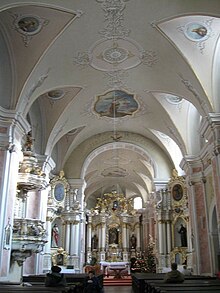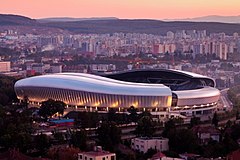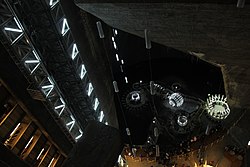Cluj Napoca
Cluj-Napoca (pronounced/хklu circle naхpo.ka/(![]() listen)in Hungarian, Kolozsvár, pronounced/хkolo Dialogueva Youth(
listen)in Hungarian, Kolozsvár, pronounced/хkolo Dialogueva Youth(![]() listen)in German, Klausenburg, pronounced/klaifies/z metasnbі//(
listen)in German, Klausenburg, pronounced/klaifies/z metasnbі//(![]() listen) is a municipality in the northwest of Romania, located in the Someşul Mic valley, 440 kilometers from Bucharest. Historical capital of the Transylvania region, today Cluj-Napoca is the capital of the district of Cluj and the Northwest economic region.
listen) is a municipality in the northwest of Romania, located in the Someşul Mic valley, 440 kilometers from Bucharest. Historical capital of the Transylvania region, today Cluj-Napoca is the capital of the district of Cluj and the Northwest economic region.
Second city of Romania (324,576 inhabitants in 2011), Cluj is the main economic center of the Northwest. The city is distinguished by a highly diversified secondary sector and by a tertiary sector oriented above all towards ICT, financial services, education and scientific research. Cluj-Napoca and its region have great potential for tourism development.
Since the city has two large communities, Romanian and Hungarian speaking, Cluj-Napoca is a deeply bicultural city. Its rich and eventful history has bequeathed a first-rate architectural heritage. In terms of living culture, today the city of Cluj is at the same time the largest cultural center of the Hungarian community in Romania and one of the most important Romanian cultural centers: its cultural institutions (theatres, libraries, art galleries, various festivals etc.) are some of the best in the entire country.
At the same time, Cluj-Napoca is the largest university center in Transylvania and the second largest university center in all of Romania. The various universities and schools in the city ensure a high level of instruction in the three historical languages of Transylvania (Romanian, German and Hungarian), as well as in French and English. These conditions favor the increase in the number of foreign students, both European and non-EU.
History
The Roman Empire conquered Dacia between 101 and 106 AD, during the reign of Trajan. The Roman settlement of Napoca was first recorded on a milestone stone discovered in 1758 in the vicinity of the town. Trajan's successor, Emperor Hadrian, offered Napoca the status of a municipality, with the title municipium Aelium Hadrianum Napocenses. Later in the II century d. C., the city gained the status of a Roman colony, Colonia Aurelia Napoca. Napoca became a provincial capital of Dacia Porolissensis, and therefore the seat of a procurator. The colony was evacuated in 274 by the Romans. There are no references to an urban settlement at this site for almost a millennium later.
At the beginning of the Middle Ages, two groups of buildings existed in the current location of the city: the wooden fortress of Cluj-Mănăştur and the civil settlement developed around the current Piața Muzeului (Museum Square), in the center of the city. Although the exact interval of the Hungarian conquest of Transylvania is unclear, the oldest Hungarian artifacts in the region date from the early part of the 10th century. After this century, the city was incorporated into the Kingdom of Hungary.
King Stephen I of Hungary made the city the seat of the Kolozs district, and King Wladislaus I founded Kolozsmonostor Abbey, destroyed during the Tatar invasions of 1241 and 1285. As for the civil colony, a castle and a village were built northwest of old Napoca, not before the end of the 12th century. This new town was settled by important groups of ethnic Germans, which would be known as Transylvanian Saxons, supported by King Stephen V of Hungary, Duke of Transylvania.
The first reliable mention of the settlement dates from 1275, in a document of King Wladislaus IV of Hungary, when the village (Villa Kulusvar) was offered to the Bishop of Transylvania. On August 19 In 1316, during the reign of Charles I of Hungary, Cluj received the status of city (civitas), as a reward for the contribution of the Transylvanian Saxons to the defeat of the Transylvanian voivode, Ladislao Kán who he was in absentia.
Many guilds were established in the second half of the 13th century, and a patrician stratum based on trade and craft production replaced the former landed elite in command of the city. Through the privilege granted by Sigismund of Luxembourg in 1405, the city decided to leave the jurisdiction of the voivodes, vice-voivodes and royal judges, and gained the right to elect a jury consisting of twelve members each year. In 1488, King Matthias Corvino (in Romanian Matei Corvin, born in Cluj in 1440) ordered that the city council, made up of one hundred members, be half made up of homines bone conditiones (the rich), and the other half by artisans; together, they would elect the supreme judge and the court. In the meantime, an agreement was reached stipulating that the council was to be made up half of Hungarians and half of ethnic Germans (Transylvanian Saxons), and that judicial offices were to be alternated..
In 1541, Klausenburg became part of the independent Principality of Transylvania, after the Ottomans occupied the central part of the Kingdom of Hungary; a period of economic and cultural flourishing followed. Although Alba Iulia served as the political capital for the Transylvanian princes, Klausenburg benefited greatly from the princes' support, establishing connections with the most important centers of Central Europe from that time, such as Kosice, Krakow, Prague and Vienna.
Religiously, Protestant ideas first arrived around the middle of the 16th century. During Gáspár Heltai's activity as a preacher, the Lutheran movement gained in importance, as did the Swiss doctrine of Calvinism. By 1571, the diet of Turda had adopted a more radical religion, the Unitarianism of Ferenc Dàvid, characterized by free interpretation. of the Bible and the denial of the dogma of the Trinity. Stephen Báthory founded a Jesuit academy in Klausenburg, with the purpose of promoting the Counter-Reformation movement: however, it was not very successful. During a year, 1600-1601, Cluj arrived to be part of the personal union of the Romanian Voivode Michael the Brave. With the Treaty of Karlowitz of 1699, Cluj became part of the Habsburg Monarchy.
In the 17th century, Cluj suffered from great calamities, being subject to plague and devastating fires. The end of this century brought the end of Ottoman rule, but the city lost much of its fortune, its municipal freedom, its cultural centrality, its political relevance and even part of its population. It gradually regained its important position within Transylvania, as the seat of the "Gubernium" and of the Diets between 1719 and 1732, and again in 1790 until the Revolution of 1848, when the Gubernium moved to Sibiu (Hermannstadt). In 1791, a group of Romanian intellectuals wrote a petition, known as the Supplex Libellus Valachorum, which was sent to the emperor in Vienna. The petition called for the equality of the Romanian nation in Transylvania with respect to the other nations ruled by the Unio Trium Nationum, but was rejected by the Diet of Cluj.
Starting in 1830, the city became the center of the Hungarian national movement within the principality. This broke out during the Hungarian Revolution of 1848, when for a time the Austrians began to take control in Transylvania, isolating the Hungarians between two fronts. However, the Hungarian army, led by the Polish general Józef Bem, began an offensive in Transylvania, managing to recapture Cluj until Christmas 1848. After the revolutions of 1848 an absolutist regime was established, followed by a liberal regime that came to power in 1860. It was in this period that Romanians were granted equal rights, but only for a short time, since in 1865 the Diet of Cluj annulled the laws voted in Sibiu, and proclaimed the old law of 1848, concerning the union of Transylvania with Hungary. Before 1918, the only Romanian-language schools in the city were two primary schools organized by the Church, and the first Romanian newspaper was published in 1903.
Since the union of Transylvania with Romania in 1918, Cluj has become a city with a Romanian majority and a cultural, educational and economic center of the region.
In 1944, the Nazis organized the Cluj/Kolozsvár Ghetto.
In 1974, Ceausescu added Napoca to Cluj (as Drobeta to Turnu Severin) for emphasizing the Latino origins of the Romanian people.
Geography
It is located in the northwest of the country, in the județ of Cluj, of which it is the capital. The city is crossed by the Small Someș River (Someșul Mic, one of the sources of the Someş River).
It covers an area of 197.5 km² and has a population of 318,000.
Climate
Cluj-Napoca has a continental climate, characterized by hot, humid summers and cold winters. The climate is influenced by the city's proximity to the Apuseni Mountains, as well as urbanization. Some Western Atlantic influences are present during the winter and fall. Winter temperatures are often below 0°C, although they rarely drop below -10°C. On average, snow covers the ground for 65 days each winter. In the summer, the average temperature is around 18°C (the average for July and August), although temperatures sometimes reach 35-40°C in mid-summer in the city center. Although the average precipitation and humidity during the summer is low, there are frequent and often violent storms. During spring and fall, temperatures vary between 13°C and 18°C, and precipitation during this time tends to be higher than in summer, with more frequent and milder periods of rain.
| Month | Ene. | Feb. | Mar. | Open up. | May. | Jun. | Jul. | Ago. | Sep. | Oct. | Nov. | Dec. | Annual |
|---|---|---|---|---|---|---|---|---|---|---|---|---|---|
| Temp. max. abs. (°C) | 14.0 | 19.3 | 26.6 | 30.2 | 32.5 | 36.0 | 38.0 | 38.0 | 33.7 | 32.6 | 26.0 | 18.7 | 38.0 |
| Average temperature (°C) | 0.3 | 3.2 | 9.9 | 15.0 | 20.3 | 22.6 | 24.5 | 24.3 | 20.7 | 14.6 | 6.3 | 1.8 | 13.6 |
| Average temperature (°C) | -3.4 | -1.2 | 4.1 | 9 | 14.2 | 16.6 | 18.2 | 17.8 | 14.1 | 8.5 | 2.4 | -1.5 | 8.2 |
| Temp. medium (°C) | -6.5 | -4.7 | -0.6 | 3.9 | 8.6 | 11.3 | 12.7 | 12.2 | 8.9 | 3.8 | -0.7 | -4.2 | 3.7 |
| Temp. min. abs. (°C) | -34.2 | -32.5 | -22.0 | -8.4 | -3.5 | 0.4 | 5.2 | 3.5 | -3 | -8.8 | -22.3 | -27.9 | -34.2 |
| Total precipitation (mm) | 24 | 20 | 22 | 48 | 69 | 95 | 81 | 60 | 36 | 31 | 30 | 32 | 548 |
| Precipitation days (≥ 1 mm) | 6 | 5 | 5 | 9 | 11 | 11 | 10 | 8 | 6 | 6 | 7 | 7 | 91 |
| Hours of sun | 70.9 | 98.9 | 165.2 | 174.7 | 230.8 | 238.6 | 273.8 | 261.6 | 204.8 | 166.2 | 74.9 | 54.7 | 2015.1 |
| Source: Hong Kong Observatory (extreme 1901-2000) | |||||||||||||
Demographics
Since the Middle Ages, Cluj-Napoca has been characterized as a multicultural city, with a significant diversity of faiths. By 2002, the city had 318,027 inhabitants, which made it the third most populous agglomeration in Romania (only behind the capital Bucharest and Iaşi).
The ethnic composition, according to official sources from 2002, is as follows:
- 252,433 Romanians (79.4%)
- 60,287 Hungarians (19 per cent)
- 1% Gypsies, 0.24% German and 0.06% Jewish.
Population evolution
The official censuses show the following population evolution in Cluj-Napoca:
- 60,808 inhabitants as at 19 December 1910; (of which 81.6 per cent were Hungarian)
- 100,844 inhabitants as at 29 December 1930; 53.3 per cent of whom were Hungarian
In August 1940, and after the Second Dictation of Vienna in which the northern half of Transylvania was granted to Hungary, there was a mass exile of the Romanian inhabitants.
- 114,984 inhabitants in 1941; (of which 87.1 per cent were Hungarian)
By 1941, a total of 16,763 Jews lived in Cluj. In 1944, they were confined to ghettos by the German occupation, and between May and June of that year they were deported to Auschwitz.
- 117,915 inhabitants as at 25 January 1948;
- 154,723 inhabitants as at 21 February 1956; (of which 50.3 per cent were Hungarian)
- 185,663 inhabitants as at 15 March 1966; (of which 42.2 per cent were Hungarian)
- 262,858 inhabitants as at 5 January 1977; (of which 32.7 per cent were Hungarian)
- 328,602 inhabitants as at 7 January 1992; (of which 22.7 per cent were Hungarian)
- 318,027 inhabitants as at 18 March 2002; (of which 18.9 per cent were Hungarian)
- 324,576 inhabitants as at 20 October 2011; (of which 16.4 per cent were Hungarian)
Famous natives and world-renowned inhabitants
- Lucian Blaga - philosopher
- Esteban Bocskai - Prince of Transylvania
- János Bolyai - mathematician
- Alexandru Borza - scientist, botanical garden founder
- Corneliu Coposu - politician
- Doina Cornea - anti-communist dissident, human rights and political activist
- Mathias Corvinus - King of Hungary
- Péter Csaba - violinist
- Ferenc Dávid - reformer and humanist, founder of the unitary church of Transylvania
- Iuliu Haţieganu - scientist, doctor and politician
- Iuliu Hossu - Catholic cardinal
- Iuliu Maniu - politician
- Andrei Marga - politician and philosopher
- Gheorghe Mureşan - basketball
- Mihai Nastase - chemical
- Florin Piersic - actor
- Esteban Pongracz - holy Jesuit martyr
- Emil Racoviţă - biologist, spyologist and explorer
- D.D. Roşca - philosopher
- Ion Raţiu - politician
- Gabriella Szabó - athlete
- Julia Varady - soprano
- Sándor Veress - composer
- Olga Lengyel - writer
- Miklós Bánffy, Count of Losoncz - writer
- Roxen - singer
Culture
There is still a strong Hungarian influence in the city, especially in its architecture. Bánffy Palace (Baroque - 18th century) became the city's art museum. Cluj-Napoca has the largest Catholic church in the country, Sfântul Mihail (Szent Mihály in Hungarian) (Saint Michael), founded in the 14th century. Unfortunately most of its sculptures and paintings were destroyed during the Reformation period.
The city is known for its botanical garden, founded by Professor Alexandru Boza.
Education
Cluj is the second largest university city in the country (home to the largest university in Romania, Universitatea Babeş-Bolyai), after the capital Bucharest. Today there are more than 80,000 students in the city, spread over 6 public and 5 private universities.
The 6 public universities are:
- Gheorghe Dima Music Academy [1] (more than 700 students)
- University of Art and Design [2] (more than 1000 students)
- Babeş-Bolyai University [3] (more than 51,000 students)
- University of Medicine and Pharmacy Iuliu Haţieganu [4] (more than 10,000 students)
- University of Agricultural Sciences and Veterinary Medicine [5] (more than 7000 students)
- Technical University [6] (more than 12,000 students)
Media
- TVR Cluj
- NCN Cluj-Napoca
Places of interest
- Cluj-Napoca Botanical Garden.
- Church of San Miguel.
- Orthodox Cathedral.
- Mihai Viteazul Square. Located in the centre of the city, it is presided over by the equestrian statue dedicated to Mihai Viteazul (Miguel el Valiente). After it we find the Cinema Republic, clear example of communist architecture.
- Statue to Matías Corvino (Matia Corvinus), king of Hungary born in this city.
Administrative organization
The city of Cluj is the capital of the Cluj district.
Health
In 2009 there were 11 hospitals in the city; and today, it already has 15.
Sports
In the automotive field, Cluj-Napoca hosts two stages in the National Rally Championship. The Raliul Clujului is held in June, the Avram Iancu Rally, held in September, has been officially organized since 1975, although there were years when it was not held. The latter starts at Cipariu Square and runs through the surrounding area of the city.
Amateur sportsmen are also active in Cluj-Napoca, with swimming pools, miniature golf courses, tennis courts, paintball fields and cycle paths, as well as skiing, bobsleighing, skating, caving, hiking, hunting, fishing and sports extremes in the surroundings. In April 2011, the first annual edition of the Cluj International Marathon took place, a competition that takes place in the streets of the city center.
Economy
Being a large industrial center, metal, chemical, ceramic, candy, beer, brush, shoe and many other factories are located nearby.
Transportation
Air transportation
- Avram Iancu Airport
Railway
- Cluj-Napoca railway station
Roads
- E60 (Bucharest - Vienna)
- E81 (Mukachevo - Bucharest)
- A3 (Hungarian border - Bucharest)
Buses
- 18 bus lines (metropolitan)
- 40 bus lines (urban)
- 7 trolleybus lines
- 3 tram lines
Cycling routes
Cluj has many sections of bike lanes (around 42km).
Twinned cities
Cluj-Napoca is twinned with the following cities:
Contenido relacionado
Italy spin
March of the volunteers
Department of Pando





